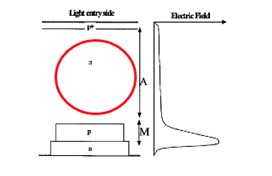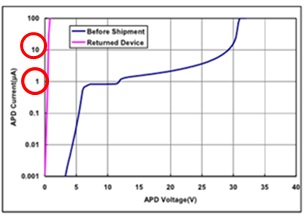Introduction
In fiber optic communication systems, transceivers play a vital role. The transmitter converts electrical pulses to light and on the receiver side, a photodetector senses the light falling on it and converts it into an electrical pattern. PIN (p-i-n) and APDs (Avalanche Photo Diode) are the most commonly used photo diodes in optical transceivers.
APD Fundamentals
Long distance communications typically use APD-based detectors for their high sensitivity and quick response time. Compared to a PIN photodiode, APD offers internal gain and has the advantage of higher sensitivity. This gain happens as a result of the avalanche effect. This is explained in the figure below.

The APD has an absorption region “A” and a multiplication region “M”. When light strikes the surface of the APD, holes and electrons are generated (in the circled region below) and carriers are swept toward the M region by the electrical field applied, where the photo current gain takes place (rectangle p). The gain, M, is about 10-40 for InGaAs (Indium Gallium Arsenide) APDs.
As the reverse bias voltage begins to increase, the gain begins to increase as well.
The voltage gain relationship is plotted in the graph below. The blue curve is that of a good APD. From the graph it is evident that to get the maximum gain of 10µA, a high reverse voltage between 28 to 30V has to be applied. As you move forward, the APD moves into breakdown. Breakdown voltage is a critical parameter of APDs and is the largest reverse voltage that can be applied before there is an exponential increase in dark current.

Another thing to note here is the effect of temperature. This curve is temperature dependent. With increase in temperature, there is a decrease in breakdown voltage. Because of this, APD designers have to track temperature carefully to compensate for this shift. If temperature compensation is not sufficient, the APD will go into breakdown mode and become useless.
Typical 25G APD parameters
These are some of the common parameters for a 25G APD.
- Reverse Voltage Vr = 17V – 21V
- 3dB BW (bandwidth) = 20GHz
- Multiplication Factor, M = 2 @ -17V, M = 5 @ -21V
- Sensitivity Ps = -17dBm for 1e-12
Conclusion
APDs with their high sensitivity are well suited for long distance fiber optic transmission. At the same time, careful operation is required because power above the maximum recommended could cause irreparable damage to the APD.
For questions and more information, contact us at sales@vitextech.com.
Related Products

